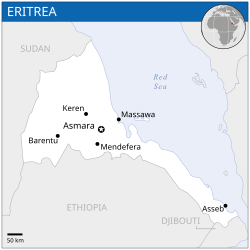Eritrea
From Wikipedia, the free encyclopedia
"Erythrea" redirects here. For other uses, see Eritrea (disambiguation) and Erythrean Sea.
Not to be confused with Eretria.
| State of Eritrea | ||||||
|---|---|---|---|---|---|---|
| ||||||
| Anthem: Ertra, Ertra, Ertra Eritrea, Eritrea, Eritrea | ||||||
|
| ||||||
|
| ||||||
| Capital and largest city | Asmara 15°20′N 38°55′E | |||||
| Official languages | none [1] | |||||
| Working Languages | ||||||
| Ethnic groups(2012[4]) | ||||||
| Demonym | Eritrean | |||||
| Government | One-partypresidential republic | |||||
| • | President | Isaias Afwerki | ||||
| Legislature | National Assembly | |||||
| Formation | ||||||
| • | Dʿmt | c. 980 BC | ||||
| • | Kingdom of Aksum | c. 100 AD | ||||
| • | Italian Eritrea | 1890 | ||||
| • | Eritrean Federation | 15 September 1952 | ||||
| • | De facto State of Eritrea | 24 May 1991 | ||||
| • | De jure State of Eritrea | 24 May 1993 | ||||
| Area | ||||||
| • | Total | 117,600 km2 (101st) 45,405 sq mi | ||||
| • | Water (%) | 0.14% | ||||
| Population | ||||||
| • | 2014 estimate | 6,380,803[2] (107th) | ||||
| • | Density | 51.8/km2 (154th) 111.7/sq mi | ||||
| GDP (PPP) | 2014 estimate | |||||
| • | Total | $7.814 billion[5] | ||||
| • | Per capita | $1,195[5] | ||||
| GDP (nominal) | 2014 estimate | |||||
| • | Total | $3.858 billion[5] | ||||
| • | Per capita | $590[5] | ||||
| HDI (2014) | low · 186th | |||||
| Currency | Nakfa (ERN) | |||||
| Time zone | EAT (UTC+3) | |||||
| • | Summer (DST) | not observed (UTC+3) | ||||
| Drives on the | right | |||||
| Calling code | +291 | |||||
| ISO 3166 code | ER | |||||
| Internet TLD | .er | |||||
Eritrea (/ˌɛrᵻˈtreɪ.ə/ or /ˌɛrᵻˈtriːə/;[7] Tigrinya: ኤርትራ? ʾErtrā ; Arabic: إرتريا Iritriyā), officially the State of Eritrea,[8] is a country in the Horn of Africa. With its capital at Asmara, it is bordered by Sudan in the west, Ethiopia in the south, and Djibouti in the southeast. The northeastern and eastern parts of Eritrea have an extensive coastline along the Red Sea, across from Saudi Arabia and Yemen. The nation has a total area of approximately 117,600 km2 (45,406 sq mi), and includes the Dahlak Archipelago and several of the Hanish Islands. Its name Eritrea is based on the Greek name for the Red Sea (Ἐρυθρὰ Θάλασσα Erythra Thalassa), which was first adopted for Italian Eritrea in 1890.
Eritrea is a multi-ethnic country, with nine recognized ethnic groups in its population of around six million. Most residents speak Afroasiatic languages, either of the Semitic or Cushitic branches. Among these communities, the Tigrinya make up about 55% of the population, with the Tigre people constituting around 30% of inhabitants. In addition, there are a number of Nilo-Saharan-speaking Nilotic ethnic minorities. Most people in the territory adhere to Christianity or Islam.[2]
The Kingdom of Aksum, covering much of modern-day Eritrea and northern Ethiopia, rose somewhere around the first or second centuries[9][10] and adopted Christianity around the time Islam had spread through Egypt and the Levant.[11] In medieval times much of Eritrea fell under the Medri Bahri kingdom, with a smaller region being part of Hamasien.
The creation of modern-day Eritrea is a result of the incorporation of independent, distinct kingdoms and sultanates (for example, Medri Bahri and the Sultanate of Aussa) eventually resulting in the formation of Italian Eritrea. In 1947 Eritrea became part of a federation with Ethiopia, the Federation of Ethiopia and Eritrea. Subsequent annexation into Ethiopia led to the Eritrean War of Independence, ending with Eritrean independence following a referendum in April 1993. Hostilities between Eritrea and Ethiopia persisted, leading to the Eritrean–Ethiopian War of 1998–2000 and further skirmishes with both Djibouti and Ethiopia.
Eritrea is a member of the African Union, the United Nations, and IGAD, and is an observer in the Arab League.






